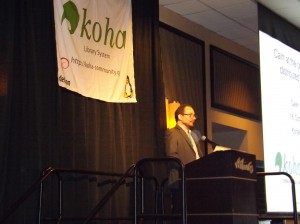Koha ILS
KohaCon13: Calm at the centers of the distributed whirlwinds
KohaCon13 opened up with a talk by Galen Charlton our 3.14 release manager. Galen started with what we have to look forward to in Koha 3.14. First and most importantly is what’s new for the patrons:
- A new OPAC theme built on bootstrap which will make Koha more modern and updated.
- Course reserves management
- Better integration with OverDrive will allow patrons to easily find ebooks via the catalog
- More secure password storage will improve system security
- Schema.org microdata will allow people to see data in your system and do interesting things with it
 On the library side there are improvements as well!
On the library side there are improvements as well!
- An HTML5 offline circulation tool will make it so that you can do offline circulation right in a Koha interface (no software needed)
- Patron lists will allow you to create lists of patrons for modification or any other reason
- Z39.50 searching of authority records means that you can copy catalog authority records from trusted sources
- Ability to merge authority records will make it so that it’s easier to clean up duplicate authorities
- DOM indexing for libraries using UNIMARC which is a step in the direction of allowing Koha to index data other than MARC
- Ability to move orders from one vendor to another easily
- Ability to check items out without a barcode – you can do this with a title or keyword
- More options for lost fine policies
- Some Serials enhancements to improve flexibility with prediction patterns
Sys admins have some things to look forward to as well:
- Improvements to package scripts
- More hooks for OPAC customizations
- System preference overriding
- Translation fixes
But that’s not it! Developers have something to look forward to too:
- DBIx::Class – a step toward supporting not just MySQL
- More and better tests to make for a better release
- More Template Toolkit Plugins which allow us to move more of the OPAC logic out of the Perl files
So how does all of the above come to be? There are some dichotomies Galen brought up. The fist is Stability and instability. You can imagine a perfectly stable Koha and a perfectly unstable Koha. The first sounds awesome – but it’s actually a trap that we don’t want to fall in to. A perfectly stable Koha becomes static and doesn’t change and doesn’t grow … and becomes obsolete very quickly. A perfectly unstable Koha is not useable – it’s fun as an academic toy – but not at all practical.
Next is innovation and conservation. “Koha is not done yet!” We have to be careful to not take away things that people need, but to not keep things that are outdated. And when adding new features we need to make sure we’re adding useful features.
Given that – what is the lifecycle of a feature according to Galen?
- Idea – maybe this comes from a patron or from a staff member frustration – or because you want Koha do act exactly like the system you just moved from
- Resistance – even though others might like your idea, there will always be someone who resists the idea
- Iteration – resistance leads to discussion and this leads to a better idea/implementation
- Acceptance – finally everyone accepts the change
- Iteration – the people take and make it look better or update it for more use cases
- Conservation – this feature is kept in place
- Destruction – the feature may no longer be needed or the feature doesn’t go away but it becomes so much of the background it’s part of the fabric of the project
Galen went on to talk a bit about more about our process and the most important thing (I think) that he said is that we’re all working toward the same thing! We may not always agree or go about it the same way, but we all want a better Koha. Galen asked us to keep gratitude in our minds.
Read more by Nicole C.
